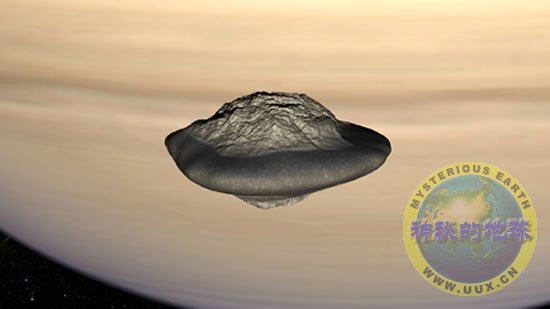Saturn's "Flying Saucer" Moons Made Mainly of Ring Dust
An illustration of Saturn's moon Atlas shows the bulging equatorial ridge that gives the satellite its flying saucer shape.
A new study suggests that this "belt" is smooth, scientist Sébastien Charnoz said, because it "is an accumulation of tiny icy particles like sand." The pole, by contrast is jagged because it is an ancient fragment of a demolished rocky moon, he added.
Illustration courtesy CEA/ANIMEA
Brian Handwerk
for National Geographic News
December 6, 2007
A new glimpse of two of Saturn's tiny moons has scientists rethinking how those satellites were created.
Once thought to be solid chunks of long-gone, larger bodies, the moons Pan and Atlas may actually be largely composed of dust and debris that has accumulated over millennia, new studies say.
This new origin theory would explain the moons' "flying saucer" shapes and perhaps shed new light on how Saturn's rings formed.
"Those little satellites that are embedded in the rings, we think, are the clues to understanding the origins of the rings," said Sébastien Charnoz, a planetary scientist with France's National Center for Scientific Research.
Explosive Start
In the early 1980s the Voyager 1 and 2 spacecraft revealed that several small moons orbit within Saturns rings. The discovery fueled speculation that the moons and rings were born of some violent ancient collision, or collisions.
Such a crash might have blasted ancient, larger moons or other bodies into fragments, creating the dust-and-debris fields that make up Saturn's rings.
The origins of the small moons, though, may not be quite so simple, according to two studies to be published in the journal Science tomorrow—one of which Charnoz authored.
As Charnoz explained it, larger chunks from the collision may well have become moons, while smaller ones became the rocky remnants that make up what look to us like flat rings.
But the two new studies show that the small moons may have drawn dust and debris to themselves, slowly expanding their size over millennia, he said.
Porous, "Flying Saucer" Moons
New data from the Cassini spacecraft show that the moons are porous and have only about half the density of water ice.
So while each of these moons may have a dense chunk of debris at its core, half or more of its present size is due to gradually growing layers of small particles that float within Saturn's rings.
This clumping together of particles likely occurred in several stages, the last of which may have resulted in the puzzling equatorial ridges that give Pan and Atlas their flying saucer shapes.
Those ridges harbor a second major clue to the origins of Pan and Atlas.
If the moons had been born inside rings, Pan and Atlas could not have grown any thicker than the rings themselves.
This means that Pan and Atlas were likely created outside the rings—for instance by the demolition of a bigger moon. Only after joining the rings' orbits did the satellites grow to their present sizes.
Matt Tiscareno, a planetary scientist at Cornell University in Ithaca, New York, called the research a good, plausible model that might have much wider implications.
"By looking at how these moons interact with the disk [ring], we can then draw conclusions about the disks around other stars and even our own early solar system," said Tiscareno, who was not involved in the study.
"This massive seed"—the chunk that forms the core of Pan or Atlas—"embedded in a gap in a disk, [looks] very much like the models of solar system formation."












